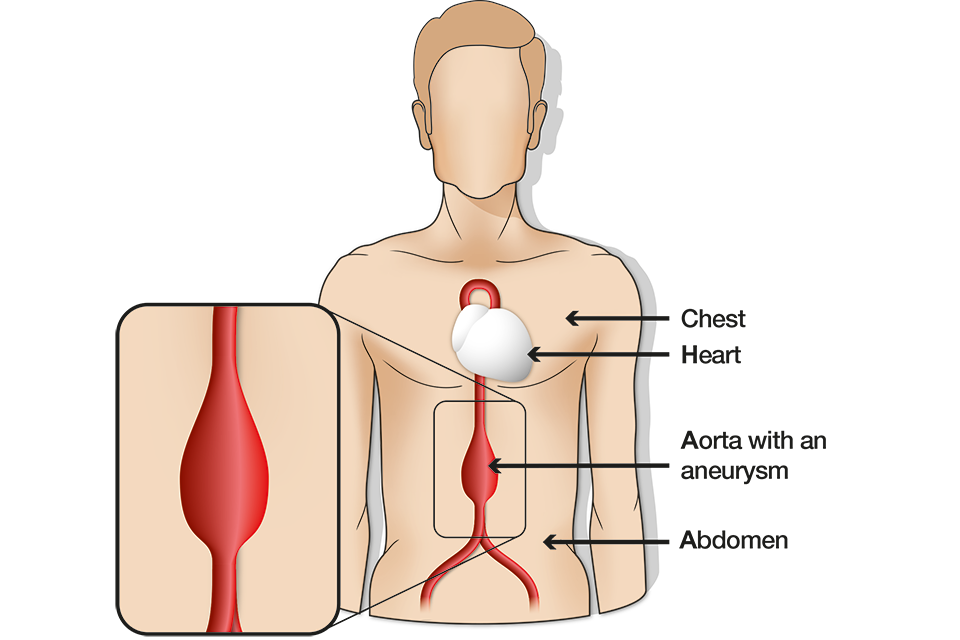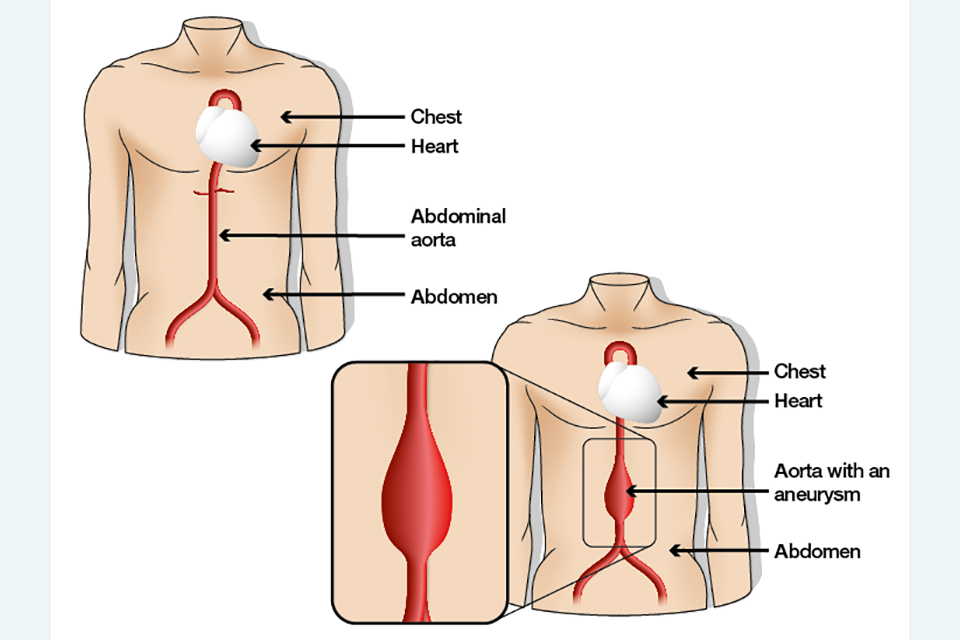Abdominal aortic aneurysm (AAA) screening, a free test for men aged 65 and over
Updated 3 July 2024

Overview
This leaflet provides information on abdominal aortic aneurysm screening (also called AAA screening) for men aged 65 and over.
It explains what an abdominal aortic aneurysm (AAA) is and what happens when you go for screening. It should help you decide if you want to be screened.
The AAA screening check is a simple free ultrasound scan.
Who we screen
The NHS invites all men for screening in the year they turn 65.
Men over 65
Men aged over 65 who have not been screened before can contact their local service to arrange a test.
Abdominal aortic aneurysm
The aorta is the main blood vessel that supplies blood to your body. It runs from your heart down through your chest and abdomen.
In some people, as they get older, the wall of the aorta in the abdomen can become weak. It can then start to expand and form an abdominal aortic aneurysm.
The condition is most common in men aged 65 and over.

The development of an abdominal aortic aneurysm.
Potential risks of an abdominal aortic aneurysm
Large aneurysms are rare but can be very serious. As the wall of the aorta stretches it becomes weaker and can burst, causing internal bleeding. Around 85 out of 100 people die when an aneurysm bursts.
An aorta which is only slightly enlarged is not dangerous. However, if the aorta measures between 3cm and 5.4cm it is important that we keep checking it to see if it is getting bigger.
Benefits of screening
If you have an aneurysm you will not usually notice any symptoms. This means you cannot tell if you have one, will not feel any pain and will probably not notice anything different.
We offer screening so we can find aneurysms early and monitor or treat them. This greatly reduces the chances of the aneurysm causing serious problems.
The easiest way to find out if you have an aneurysm is to have an ultrasound scan of your abdomen.
Around 1 in 92 men who are screened have an abdominal aortic aneurysm.
Risk factors
Men are 6 times more likely to have an abdominal aortic aneurysm than women, which is why women are not offered screening. The chance of having an aneurysm increases with age.
Your chance of having an abdominal aortic aneurysm can also increase if:
- you are or have ever been a smoker
- you have high blood pressure
- your brother, sister or parent has, or has had, an abdominal aortic aneurysm
AAA screening test
We use a simple ultrasound scan, similar to that offered to pregnant women. This is very quick and usually lasts less than 10 minutes.
At the clinic we will check your personal details, explain the scan and give you the chance to ask any questions.
We will ask you to lie down and lift up or unbutton your shirt. You will not need to undress. We will put a cool gel on your abdomen.
We will then slide the scanning sensor over your skin. The scan will show a picture of the aorta on a screen and we will measure it.
We will tell you your result straight away and also send a copy to your GP practice.
Possible screening results
There are 4 possible results:
- no aneurysm found
- small aneurysm
- medium aneurysm
- large aneurysm
No aneurysm found
If your aorta is less than 3cm wide, this means you do not have an aneurysm. Most men have this result. No treatment or monitoring is needed afterwards. We will not invite you for AAA screening again.
Small aneurysm
If your aorta is between 3cm and 4.4cm wide, you have a small aneurysm. We invite men with a small aneurysm back for scans every 12 months to check if it is getting bigger.
Medium aneurysm
If your aorta is between 4.5cm and 5.4cm wide, you have a medium aneurysm. We invite men with a medium aneurysm back for scans every 3 months to check if it is getting bigger.
Large aneurysm
If your aorta is 5.5cm wide or bigger, you have a large aneurysm. Only about 1 in 1,000 men who are screened have a large aneurysm. We give men with a large aneurysm an appointment with a specialist team to have more scans and talk about possible treatment, usually an operation.
Monitoring a small or medium aneurysm
If you have a small or medium aneurysm you will not need treatment at this stage. However, it is important to monitor the size of the aneurysm as you might need treatment if it gets bigger. Most aneurysms get bigger very slowly, so many men with a small or medium aneurysm will never need treatment.
We will invite you to come back for scans every year if you have a small aneurysm or every 3 months if you have a medium aneurysm.
We will give you advice on reducing the chance of the aneurysm getting larger. Your GP practice may also want to give you tablets or review your current medication. They may also want to check your blood pressure.
Treating a large aneurysm
If we find a large aneurysm, we will refer you to a specialist team. They will carry out some more tests and a specialist will discuss possible treatment with you. This is typically an operation, usually arranged within a few weeks if you decide you want it.
During the time when a large AAA is untreated, you may need to stop driving and to check health-related insurance, such as travel insurance.
Treatment for aneurysms that are found using screening is usually very effective. There are risks from treatment which will be explained in detail by the specialist.
Not everyone who has a large aneurysm will have an operation.
Risks from screening
There is no risk from the scan itself.
However, around 41 out of every 10,000 men screened will eventually have surgery to repair an aneurysm. On average, 1 of these 41 men will not survive the operation but their aneurysm may never have burst if left untreated.
Screening does not completely remove the risk of an aneurysm bursting but it is the best method of protection against this condition.
Other conditions
Screening is just to see if you have an abdominal aortic aneurysm. It does not look for other conditions. If you are worried about any medical problem you should speak to your GP practice.
Accuracy of screening test
The scan used to find aneurysms is very reliable. No screening test can be completely effective but it is very rare for a man to develop a large aneurysm if no aneurysm is found by screening.
Sometimes the person carrying out the scan will not be able to see the aorta clearly. This is nothing to worry about and they will ask you to have another scan, usually on a different day.
Confidentiality
The NHS screening programmes use personal information from your NHS records to invite you for screening at the right time. NHS England also uses your information to ensure you receive high quality care and to improve the screening programmes. Find out more about how your information is used and protected, and your options.
More information
If you have been invited for screening, the phone number for your local screening service is on your appointment letter.
Find contact details for your local AAA screening service.
The Circulation Foundation and the British Heart Foundation support people with diseases of the veins and arteries, known as vascular diseases, including abdominal aortic aneurysms.
You can also speak to your GP practice.
Find out how to opt out of screening.
